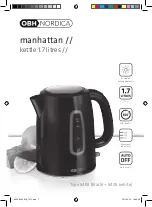
10
Do not fill with less than 0,3 litre of water
to prevent
the kettle running dry while operating; misuse of this kind
will shorten the life of the element.
Do not fill with more than 1.7 litres of water
(up to
the MAX level).
If the kettle is overfilled, there is a risk
that boiling water may be ejected causing burns.
Switching on
- Plug the power base into the
mains socket.
- Place kettle on power base.
- Press the ON/OFF
switch
down (fig. 5) to switch the
kettle on.
- The pilot light will switch on.
- The kettle will automatically
switch off once the water is boiled (the ON/OFF switch will
click upwards and the lights will switch off ).
- To turn the kettle off before the water boils, you may move
the ON/OFF switch up to the OFF position, or simply lift the
kettle from its base - it will switch off and the switch will
return to the OFF position automatically.
Pouring
- Remove the kettle from the power base and carefully pour
out the water. Do not tilt the kettle suddenly or pour water
out at too sharp an angle.
- When you lift the kettle from the base, you may see
moisture on the top surface of the base. Condensation on
the base is perfectly normal, and should not be a cause for
alarm.
SAFETY DEVICES
1) Automatic ON/OFF switch:
Your kettle is fitted with an ON/OFF switch which
automatically switches off once the water has boiled. If the
kettle has just boiled, wait a minute or so before re-boiling
the kettle. Do not attempt to hold the ON/OFF switch in the
on position or adjust the switch mechanism.
2) Safety cut-out:
If the kettle is switched ON with too little or no water, it is
protected against damage by a safety cut-out which will
switch off the power. If this cut-out operates, disconnect
the kettle from the mains supply and leave to cool down
before refilling with cold water (otherwise the element
could be damaged).
3)
If kettle is lifted from base while operating (ON), it will
automatically switch off.
MAINTENANCE
Cleaning the kettle
- Allow the kettle to cool down fully and disconnect the
appliance from the mains before cleaning.
- Do not immerse the kettle or base in water.
- Use a soft dampened cloth to wipe the outside of the kettle
and dry with a soft, dry cloth.
- DO NOT use metal polish or harsh scouring agents.
- Ensure that all connectors and sockets are kept dry.
Scale
Scale is mainly calcium carbonate (chalk), a harmless, naturally
occurring mineral found in most water supplies. “Hard” water
contains more of this mineral than “soft” water. When the water
is heated, the minerals in the water solidify, making the water
appear cloudy. These minerals form a thin film on the walls,
element and on the surface of the water. The water may look like
it has white coloured pieces of plastic floating on the surface.
On traditional kettle elements, scale forms a hard white “crust”
which adversely affects performance and reduces the life of the
element. As soon as you notice a film forming on the water, or,
when cleaning the filter, if you notice a film on the walls or the
element, simply rinse the kettle and wipe it out.
Scale filter
Your kettle is fitted with a scale filter to prevent loose particles
of scale being poured into your beverage. This filter is both
removable and washable. The frequency with which you will
need to clean any scale deposits from your filter will depend
on the hardness of water in your area and how often you use
the kettle. You should remove and clean the water filter when
you notice any deposits being left on the filter or if the pouring
efficiency is impaired.
Removing the scale filter
- Allow the kettle to cool down fully.
- Disconnect the appliance from the mains electrical supply.
- Make sure that your hands are clean and free from soap,
cream or anything which might taint the water.
- Empty the kettle and remove the filter as shown in fig. 1.
- Rinse under a tap whilst brushing with a soft brush (fig. 2).
- Replace the filter (fig. 3).
To clean the scale filter
It is vital to clean and descale regularly in order to maintain good
working order.
- Use descaler for kettles. When limescale starts forming on
the heating element, buy a suitable descaler and descale
according to the instructions given on the descaler pack.
After descaling, boil the kettle repeatedly with fresh water
and rinse thoroughly to completely eliminate all residues
of descaler which could damage the appliance. If the
filter requires descaling, remove and immerse in the same
descaling solution.
- Make sure electric parts are completely dry before using
the kettle.
5





















